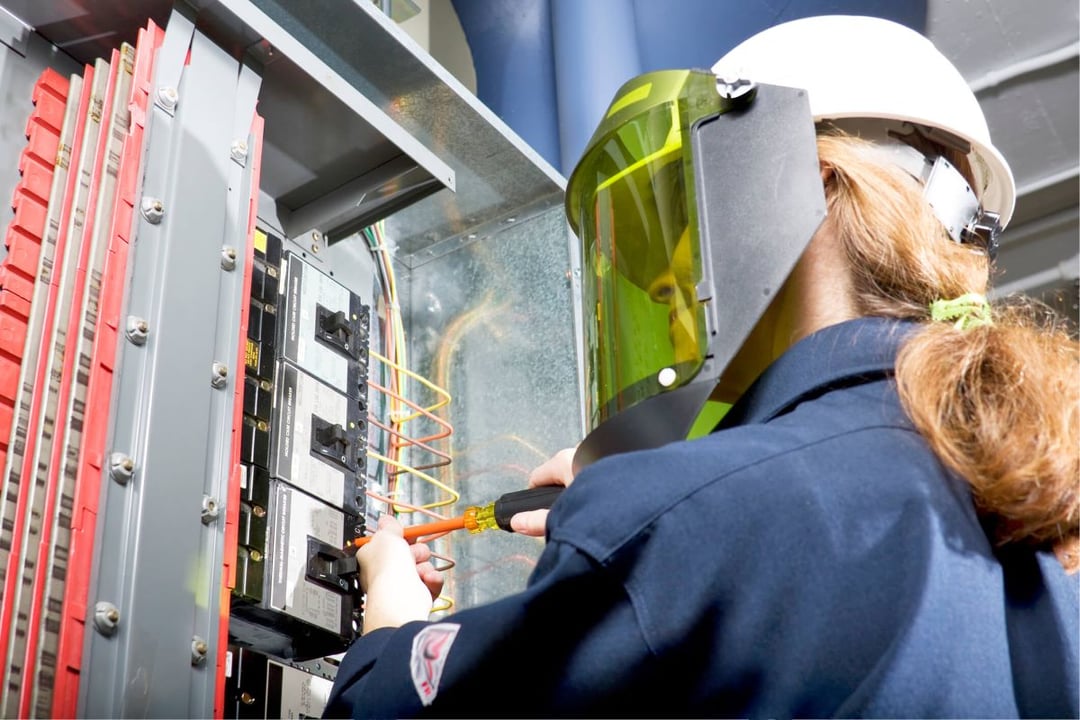
Arc flashes are a common and dangerous hazard for data center workers. Fortunately, there are arc flash safety steps you can take to keep workers protected. Learn more about this hazard and how to prevent it from causing workplace injuries or fatalities.
What is an arc flash?
An arc flash, also called a flashover, occurs when an electrical current leaves its intended path and flows through the air, either from one conductor to another conductor or to ground, causing an arc blast pressure wave. Exposure to an arc flash can result in serious injuries or even death.
How common are arc flashes?
Arc flashes are an all-too-common hazard in modular data centers and other facilities with electrical equipment. It’s been estimated that 5-10 arc flash explosions occur in electric equipment in the U.S every day. These incidents result in more than 3,600 disabling electrical contact injuries annually.
In the worst cases, these incidents can result in fatalities. Occupational Safety and Health Administration (OSHA) reports of workplace fatalities show that there were 179 electric arc and burn fatalities over the course of 34 years, which equates to more than five reported electric arc and burn workplace fatalities every year.
How do arc flashes harm workers?
Arc flashes can result in various injuries, which are all serious. These injuries can be :
- External burns: One of the most common ways arc flashes harm workers is by causing their clothing to ignite, quickly resulting in serious burns. The charged particles that result from an arc flash can also be attracted to metal objects on a person, such as a wristwatch or eyeglasses, which causes these objects to become extremely hot, severely burning the wearer.
- Internal burns: Arc flashes also produce a cloud of toxic gas composed of ionized particles and plasma. Inhaling this ionized gas can cause severe internal burns in the lungs and airways.
-
- Eyesight and hearing loss: A high-intensity flash can also have ramifications for a person’s eyes, causing the corneas to become irritated and potentially damaging eyesight. The intense sound from an arc flash explosion, which can reach as high as 160 decibels, can also rupture a person’s eardrums and cause hearing loss.
-
- Physical impact: Since an arc flash involves an explosion, anyone in the immediate area can become injured by being thrown, which can result in head trauma or other serious injuries. Flying objects can also strike a person and cause cuts.
How can arc flashes occur?
Arc flash incidents can be caused by a variety of factors. Some common ones are:
- Human error: Data centers should have arc flash safety procedures in place, but workers may at times fail to follow the proper safety precautions. Plus, simple accidents such as dropping a tool or inadvertently touching the electrical equipment can cause an arc flash.
-
- Inadequate maintenance: A lack of proper maintenance can also increase the risk of arc flashes occurring. For example, dust and debris buildup or corrosion on the surface of a conductor combined with high humidity creates an electrical path.
-
- Flawed electrical system: Improper system design or faulty electrical equipment can also be the culprit. For instance, if interrupting devices are not designed to withstand the peak current conditions, if exceeded can result in a catastrophic failure of the equipment. .
How do you improve arc flash safety?
To improve your arc flash safety, you should start by commissioning an arc flash study. Such a study, conducted by an electrical engineer, is aimed at identifying arc flash hazards associated with electrical equipment in your modular data center. In other words, an arc flash study can help you understand the risks you’re dealing with and help to mitigate them, so you can stay safe on the job.
The electrical engineer will, ensure the equipment is designed for the application and determine at what proximity to the equipment is necessary to wear personal protective equipment (PPE). This point is known as the arc flash protection boundary. Staying outside of this area or wearing proper PPE within the area can minimize workers’ chance of experiencing burns if an arc flash occurs.
PCX has a team of experts that can conduct an arc flash study specific to your facility to ensure you’re using the appropriate level of caution for arc flash safety.
Want to learn more about arc flashes? Check out our arc flash study infographic.


Comments